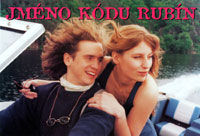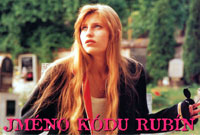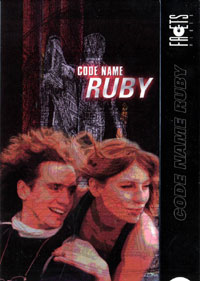Introduction
When Jan Němec, ever the advocate of "pure film," came to making his 1996 picture Jméno kódu Rubín (Code Name Ruby) he chose to put down his thoughts and feelings about the picture in written form, with the help of Miloš Fryš. The result was a series of three articles that appeared in Czech in the Prague-based journal Film a doba under the title Život filmu, který není vidět. The first two parts were written in March and June 1995 respectively when the film was still in preparation, and the last part was published in 1997, when the film had been completed.
Here they appear for the first time in translation, and, although they principally talk about just one feature that Němec has made, they are a remarkable record of the working philosophy and energy that his driven him throughout his film-making career.
Jméno kódu Rubín itself is film that reinvents history and transforms it into a new reality. Historical events, notably the Second World War, are given a mystical new meaning by placing archive footage of them in the context of a new story: an alchemistic search for the philosopher's stone.
Pitted against the Nazi's quest for absolute power, are Michal and Rubín (Ruby), who also seek the philosopher's stone, although for far less malevolent purposes. It is Rubín who manages to find the ancient secret, and as a result is crowned queen.
Part OneI
Jméno kódu Rubín has nothing in common with realism; it is a thing of fantasy; spiritual, artificially created reality. All my life I have felt that film is much closer to music than to anything else. It means that I work with fantasy, imagination, tones, rhythm, harmony and feelings. Film influences the non-rational spheres of human life.
My story is actually a fairy-tale. However, today "fairy-tale" is an overused word, and many have been made into films. The classic writers of fairy-tales, such as the Grimm Brothers, Andersen or Božena Němcová would turn in their graves, because their magic and mystery has gone. My film is a fairy tale because it could never happen, has never happened and will never happen.
It could happen only in the imagination, in the unreal world. The theme of the film is alchemy. It is heat, so thus fire which destroys, but also creates. It can be a heat of the mind, a philosophical heat, a spiritual heat. The change of a state by the power of something foreign and mysterious, which gives life to something else.
My story actually shows how, under many circumstances and ingredients, something new comes to life, something that has not existed before. Alchemy is actually a mystery and taciturnity, so I only slightly open the doors to that mystery. This is why the film is called Jméno kódu Rubín, it is the same if the whole of the Congress Library, the largest library in the world, were concerned with alchemy and I pull out one tiny tome and leaf through it. The tomes have a number, their own code. And so the story of the girl from Prague, Rubín, is only a tiny fraction of what could happen in the field of alchemy.
II
The film structure is multi-layered. The basic story is simple, banal even. Boy meets girl, they get to know each other, form a relationship and on the basis of this relationship miracles occur, divine and cosmic powers are unleashed. Through love, magic is created; through love, magic is destroyed. It is a question of whether the magic and the relationship will sparkle so that the phantasm and unreality occur again.
The film can also be characterised as 82 minutes of wooing, which is about everything they can possibly experience, how they get to paradise together. That is the readable, understandable level and into this simple situation, which everyone has experienced, all the others levels enter. The readable line of the story, in terms of the programme, stands against the exclusivity of the form. Compare: Milan Kundera (The Unbearable Lightness of Being, Immortality). If we narrated the stories of Milan Kundera's novels, we would find them quite simple. What is fascinating about these books is what develops around the story: historical connections, politics.
There is a basic theme in my film, the mystery of alchemy, enriched and filled with parallel levels. These connections are nowadays political, but their levels are mystifying and this new reality will be put forward as truth (documentaries and stylised documentaries).
We can see this multi-layeredness in my attitude to the protagonists of the three parts of the GEN series [Gallery of the Elite of the Nation, a TV series in which directors picked somebody famous and made a documentary about them], which I directed—Ester Krumbachová, Arnošt Lustig and Jan Hammer Jr. Each part was filmed in a different way and focused on different things. The multi-layeredness would be more obvious if we joined all three GEN programmes together.
I have some reservations with Robert Zemeckis's film Forrest Gump (1994), but I like the element of mystification; the idea that its hero took part in all the events of modern American history. Woody Allen has done it before in the film Zelig (1983), however it was not as bombastic and patriotic.
III
I have just finished with several days of shooting the original exhibits from the "Alchemy in the Czech Republic" exhibition and the originals from the exhibition of Josef Váchal, "The Great Alchemist." Alchemy is a fragile topic, moreover everybody views it differently, everybody mixes the mix differently, because—I stress—it is a mystery only until someone actually expresses himself, then the mystery is lost.
I jokingly say that I imagine this film as invisible. Only the person who is in tune with it will be able to see and hear it. Its sound will be the ultrasound, it will not be audible, it will take place in darkness, but the darkness will either be blue, green, brown or gloomy, the film will be shot in shades of silence. I have read that on CDs and new technologies, which totally recreate the original sound, you can recognise the sound engineers according to the quality and level of the silence. It is also how the conductor holds the tension and pauses before the next instrument plays.
The quality and level of the silence is part of the recording and the interpretation of the music, it grabs our attention while listening it. You can buy 22 recordings of the same Beethoven symphony and each of them is different. The wind and brass sections, the violins each have a different power, different rhythm, different accent, some are more dramatic or more lyrical. Suddenly you find moments of silence, although you cannot hear it, it still influences you.
So the ideal film would be without any co-workers, without me, if these influences and spiritual powers could convey themselves onto the sound and picture and from there onto the audience. The unclean, the real, which enters the film is bad for the work.
I have had this abstract debate with the cameraman Jaromír Šofr, who made O slavnosti a hostech (The Party and the Guests, 1966) with me and who is now is the main teacher of photography at FAMU [Prague's film school]. He said if a silent film without sound existed, why couldn't a film without pictures exist.
This is obviously a practical absurdity, but now we have the 100th anniversary of film and film, pure film, doesn't really exist, most films can be told by other mediums, its specificity has disappeared. That is why silent alchemy can revitalise film and is also one of the reasons why I am shooting this film. It is not an experiment; it will have a top and a bottom, a beginning and an end. I have been aware of, thought out and modified the story for a number of years and the grant I received from the State Fund for the Support and Development of Czech Cinematography has given me absolute creative freedom but not freedom to be irresponsible in production.
It means that I have to make something that is communicable, but still original. Again we are offered the possibility to open the mysterious gate of film like a certain mystery.
Jean Renoir has conceived the best definition of film. He said that film is like ceramics. You have an image, you have a form, you have clay, hands, a mood, you mix it and everything is ready. What is going on inside the oven, inside the heat, inside the fire? Only there something arises—and you can never influence it. In the end, a piece of work arises which is completely new, different from what you have prepared. It means that unknown forces are working here, the element of mystery.
In this project, with the theme of alchemy, the man is contradicting himself, but even such counterpoints belong here, even the discords are energies which are cast together and are part of the final shape. Robert Bresson made a film that has been completely forgotten today but which I supported—absolutely.
When I was in the United States, I found out that 99.9 per cent of local filmmakers had never heard of the Robert Bresson. His Un condamné ŕ mort s'est échappé (A Man Escaped, 1956) is a documentary about how to escape from prison by revealing the plot in the title of the film.
For a person raised on American films, the film is quite unacceptable. But it is a film about the spiritual power of a man who could be executed at any moment and who has the strength to escape this. It is a very spiritual, pure film. Several bars from Mozart's music can be heard throughout, which feels like a quotation from a different sphere. The film ends with the man disappearing into the darkness...
IV
For the first time I am shooting a full-length film. I am producing it myself, but this is a necessary condition for a person to be forced to unity and responsibility. The director should have at his disposition the best symphony and to be a conductor means to chose the best players, to have the best score and then to conduct with the best results.
Unlike a live concert, it is not possible to shoot a feature film live. These are all the motives and signs for the journey to the unknown. I set out on this journey not through experimentation, but with rules or with a score which has already been prepared and handed out. I think that my score is of top quality, I know I will be the conductor and I will assign the individual players to different sections—brass, strings, drums, soloists.
In the meantime, in musical parlance, I am filming the individual sections of the orchestra. To describe the film in more detail makes no sense now. We do not reveal our secrets in advance. If we are holding trumps in our hand, we keep them to the last moment. We don't play the ace of trumps first, we hold on to it until the final hand.
Part Two
I
The film Jméno kódu Rubín has radically changed with the entrance of the cameraman F A Brabec. We asked him to cooperate after he won a Český lev (Czech Lion) in 1994 for photography. I managed to convince him to do the film before he devoted himself to his own project (his directorial debut Král Ubu / King Ubu, 1966). He committed himself to this project, which is a bit different from what he has worked on previously and he began working with a generation of filmmakers with whom he has never worked with before.
He told me, "What you have in mind must be seen in the film, it must be recordable." Suddenly I was forced to abandon my philosophical and aesthetic dreams and come back down to the field of film reality. I still hold to what I spoke about previously, darkness and silence, but it will be only in short moments.
Before the arrival of František Brabec, I worked on the project for too long on my own, without a partner I respected. Since his arrival, I have been forced to transfer my energies on to what actually occurs in the film. František is a very particular man; he does not film shadow or fog, but what is actually happening, faces and what hides behind them.
In any case, it is not an unplanned expression, and that is why I think that I have found a completely ideal co-worker. Things happen the way they are supposed to and the dream level has obtained a visible form. It is such a special stage, when I try to convey abstract thoughts and feelings in a visual way.
It resembles the developing process for a photograph. From this point of view I consider František's contribution as quite remarkable. Although we see what is occurring in the film, the hidden places still remain. From what has been shot so far, it would be quite a pleasant, understandable film of about an hour... And of course I am looking forward to making the film less visible and filling in the other narrative levels after finishing shooting on the last day of June. This means that I will include documents, silent parts, sounds, I will suppress the realistic dialog and add the music.
I will now return to Renoir's comparison of film as ceramics, which I talked about last time: an elegant jug leaves the oven, I take a hammer, I smash the jug and keep all the shards. Then I stick them back together in a slightly different form, I use a piece of wire, which changes the shape of the jug, and maybe I add something else, affix another shard.
I have an explanation or excuse for such activity. It is the statement made by William Faulkner right after he was awarded the Nobel Prize. In answer to the question, if it still makes any sense after such an award to continue writing, he said, "Each of my completed works is only a monument to my absolute failure."
II







